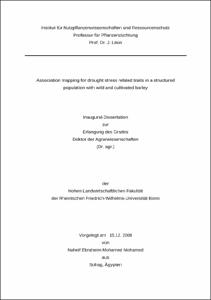Association mapping for drought stress related traits in a structured population with wild and cultivated barley

Association mapping for drought stress related traits in a structured population with wild and cultivated barley

| dc.contributor.advisor | Léon, Jens | |
| dc.contributor.author | Naheif, Ebraheim Mohamed Mohamed | |
| dc.date.accessioned | 2020-04-13T15:59:14Z | |
| dc.date.available | 2020-04-13T15:59:14Z | |
| dc.date.issued | 16.02.2009 | |
| dc.identifier.uri | https://hdl.handle.net/20.500.11811/3937 | |
| dc.description.abstract | Association mapping is an alternative to mapping in a biparental population. A key to successful association mapping is to avoid superior associations by controlling the population structure and the kinship relations. A structured population of 119 wild and cultivated barley genotypes (98 accessions of wild barley H. vulgare ssp. spontaneum from a core collection and 21 german spring barley cultivars) was used in this study. The experiments were carried out in plastic green house tunnels at Bonn University (Nord-Rhine-Westfalia, Germany) during the summer seasons 2007 and 2008. Pots were arranged in a split-plot design with non-replications; drip irrigation treatments were “well-watered” and “drought stress” with about half of the water amount in a period of 21 days starting 40 days after sowing. After that (before anthesis) plants were analysed and phenotypic data from in total 18 shoot, root and physiological traits were measured. The 119 accessions were genotyped by using 1081 DArT markers and the association analysis was performed with a mixed linear model (MLM) including Q and K matrix considering the population structure and the kinship relations. The shoot traits wilting score (WS), shoot fresh weight (SFW), the root traits root length (RL), root fresh weight (total fresh weight RFW, FWa 0-10cm length, FWb 10-20cm length, FWc greater 20cm length) and root dry weight (RDW, DWc) and the the physiological traits relative water content (RWC) and proline content (PC) exhibited highly significant differences between the two irrigation treatments “well-watered” and “drought stress” in both seasons. In the association analysis 79 markers were significantly correlated with the studied traits covering the whole genome of the structured Barley population. Different QTLs have been identified for different shoot, root and physiological traits. They are located all over the whole barley genome. These QTLs had main and / or interaction effects on improving or reducing the traits under well-watered and drought stress conditions. Thirty co-locations of QTLs were found correlating with the studied traits covering the whole genome of the tested Barley population. Among these co-locations 18 regions were found to be associated with two traits, six co-locations with three traits and six co-locations were affected by more than three traits. The most important co-locations which have been obtained in the current study were bpb- 3574 on chromosome 2H (49.03 cM) associated with RL and RWC, bpb-2910 on chromosome 3H (51.59 cM) associated with RWC and total shoot dry weight (SDW) and bpb-1408 on chromosome 4H (60.04 cM) associated with WS, RL, FWc, RWC and PC. | en |
| dc.description.abstract | Assoziationskartierung für Trockenstress-relevante Merkmale in einer strukturierten Population von Wild- und Kulturgersten Assoziationskartierung ist eine Alternative zur Kartierung in einer bi-parentalen Population. Schlüssel zu einem erfolgreichen Mapping ist es, übergeordnete Verbindungen durch Kontrolle der Populationsstruktur und der Verwandtschaftsbeziehungen zu berücksichtigen. In dieser Studie wurde eine strukturierte Gerstenpopulation aus Wild- und Kulturgersten genutzt (98 Wildgerstenakzessionen H. vulgare ssp. spontaneum aus einer Core-Collection und 21 deutsche Sommergerstensorten). Die Experimente wurden während der Sommervegetationszeiten der Jahre 2007 und 2008 in Kunststofffolientunneln am Standort der Universität Bonn-Poppelsdorf (Nordrhein-Westfalen, Deutschland) durchgeführt. Die Gefäße wurden in einer Spaltanlage ohne Wiederholungen arrangiert; die Tropfbewässerungsvarianten waren „Voll Bewässert“ und „Trockenstress“ mit etwa der Hälfte der Wassermenge in einer Periode von 21 Tagen angefangen 40 Tage nach der Saat. Danach (vor der Blüte) wurden die Pflanzen analysiert und phänotypische Daten von insgesamt 18 Trieb-, Wurzelund physiologischen Merkmalen erhoben. Genotypisiert wurden die 119 Akzessionen mit 1081 DarT-Markern. Die Assoziationsanalyse wurde unter Einbeziehung der Q- und KMatrix zur Berücksichtigung von Populationsstruktur und Vewandtschaftsbeziehungen mittels eines Mixed-Linear-Model (MLM) durchgeführt. Die Triebmerkmale Welkegrad (WS), Triebfrischgewicht (SFW), die Wurzelmerkmale Wurzellänge (RL), Wurzelfrischgewicht (Gesamtwurzelfrischgewicht RFW, Teilwurzelfrischgewicht 0-10cm Wurzellänge FWa, FWb 10-20cm Länge, FWc größer 20cm Länge) und Wurzeltrockengewicht (RDW, DWc) sowie die physiologischen Mermale Relativer Wassergehalt (RWC) und Prolingehalt (PC) wiesen höchst signifikante Differenzen zwischen beiden Bewässerungsvarianten in beiden Jahren auf. In der Assoziationsanalyse waren 79 Marker signifikant mit allen untersuchten Merkmalen korreliert. Sie fanden sich über das gesamte Genom der strukturierten Gerstenpopulation verteilt. Verschiedene QTLs für verschiedene Trieb-, Wurzel- und physiologische Merkmale wurden identifiziert. Sie zeigten Haupt- und / oder Interaktionseffekte, die die Merkmale unter „Voll Bewässert“ und „Trockenstress“ sowohl verbesserten als auch reduzierten. Es wurden 30 Co-Lokationen von QTLs gefunden, von denen 18 Regionen mit zwei Merkmalen, 6 Regionen mit 3 Merkmalen und 6 Regionen mit mehr als 3 Merkmalen assoziiert waren. Die wichtigsten Co-Lokationen waren bpb-3574 auf Chromosom 2H (49.03 cM) assoziiert mit RL und RWC, bpb-2910 auf Chromosom 3H (51.59 cM) assoziiert mit RWC und Gesamttriebtrockengewicht (SDW) und bpb-1408 auf Chromosom 4H (60.04 cM) assoziiert mit WS, RL, FWc, RWC and PC. | en |
| dc.language.iso | eng | |
| dc.rights | In Copyright | |
| dc.rights.uri | http://rightsstatements.org/vocab/InC/1.0/ | |
| dc.subject.ddc | 630 Landwirtschaft, Veterinärmedizin | |
| dc.title | Association mapping for drought stress related traits in a structured population with wild and cultivated barley | |
| dc.type | Dissertation oder Habilitation | |
| dc.publisher.name | Universitäts- und Landesbibliothek Bonn | |
| dc.publisher.location | Bonn | |
| dc.rights.accessRights | openAccess | |
| dc.identifier.urn | https://nbn-resolving.org/urn:nbn:de:hbz:5N-16699 | |
| ulbbn.pubtype | Erstveröffentlichung | |
| ulbbnediss.affiliation.name | Rheinische Friedrich-Wilhelms-Universität Bonn | |
| ulbbnediss.affiliation.location | Bonn | |
| ulbbnediss.thesis.level | Dissertation | |
| ulbbnediss.dissID | 1669 | |
| ulbbnediss.date.accepted | 03.02.2009 | |
| ulbbnediss.fakultaet | Landwirtschaftliche Fakultät | |
| dc.contributor.coReferee | Dehne, Heinz-Wilhelm |
Dateien zu dieser Ressource
Das Dokument erscheint in:
-
E-Dissertationen (1108)




